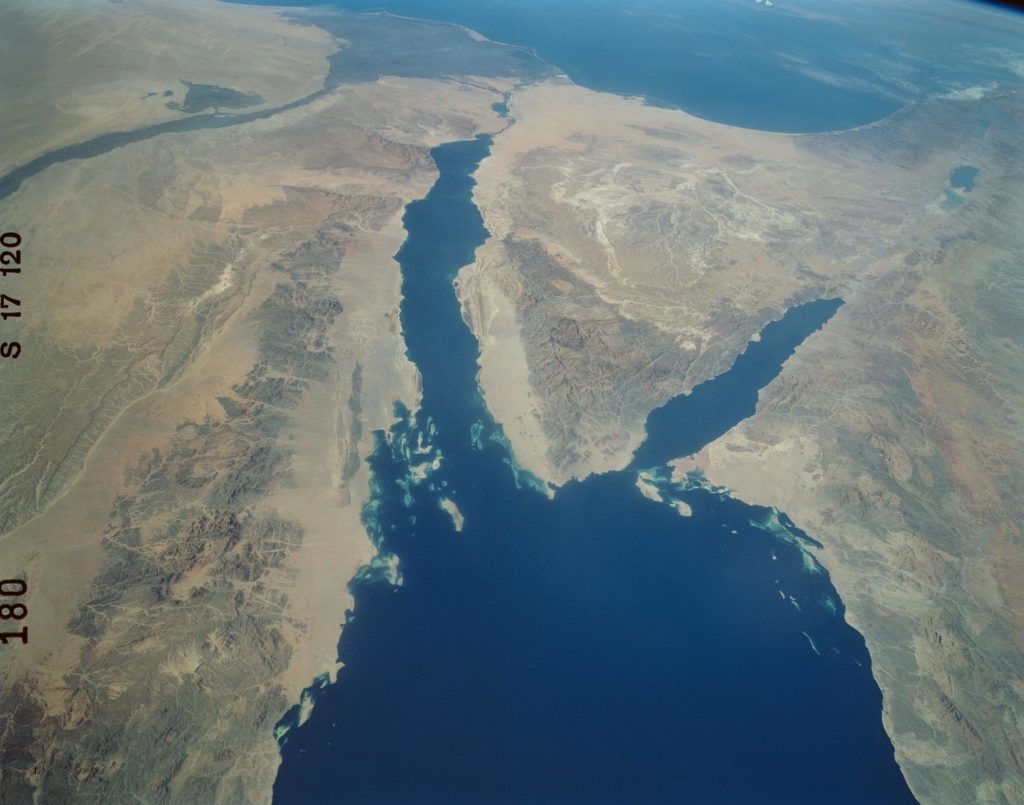Debating Ideas reflects the values and editorial ethos of the African Arguments book series, publishing engaged, often radical, scholarship, original and activist writing from within the African continent and beyond. It offers debates and engagements, contexts and controversies, and reviews and responses flowing from the African Arguments books. It is edited and managed by the International African Institute, hosted at SOAS University of London, the owners of the book series of the same name.

Panoramic-sinai-peninsula-red-sea- Credit: NASA
In a recent blogpost, Ahmed Ibrahim and Nisar Majid discussed Somalia’s recent admission to the UN Security Council, utilising the concept and practice of sovereignty to contrast the country’s favourable external recognition (external sovereignty) with its rather limited internal legitimacy and authority (internal sovereignty). They referred to the positions of Somaliland and Al Shabaab for their analysis.
We continue this discussion in relation to the current tensions across the Red Sea arena, involving Egypt, Ethiopia, Djibouti and Somalia in particular, and the Federal Member States (FMS) within Somalia.
The highly controversial MoU between Ethiopia and Somaliland that potentially trades maritime access for Ethiopia with recognition of Somaliland has set in train a number of further developments, both within the greater Horn of Africa and within Somalia. Prominent amongst these are Somalia’s security pact with Turkey and then with Egypt, and most recently, Djibouti’s offer to Ethiopia of seaport access, through Tadjourah.
The security pact between Somalia and Egypt has been accompanied by the very public movement of military equipment into Somalia, as well as talk of large numbers of Egyptian troops coming in to replace or supplement the ongoing drawdown of the African Transition Mission in Somalia (ATMIS) peace support operation, which has been critical to holding and protecting government and international facilities in Somalia.
The engagement of Egypt in Somalia should be seen through two lenses, firstly as a reverberation of the conflict in Gaza, where Arab/Muslim states appear impotent and Western powers are perceived as biased. Secondly, in relation to ongoing Ethiopia-Egypt tensions around the Grand Ethiopian Renaissance Dam (GERD), as well as the threat to Egypt that a future Ethiopian naval capacity might mean to the control of traffic (and revenue) through the Suez Canal.
These regional tensions are playing out and are manifest within Somalia as political elites at the national and sub-national levels are able to instrumentalise the dynamics for their own domestic political objectives.
International intervention and domestic dynamics
It is generally well accepted that the federal arrangement in Somalia, and its re-acceptance as a sovereign state in the international order in 2012, was in large part a project of the international community, including its near neighbours, Ethiopia and Kenya. Somalia’s political settlement was based on an elite bargain structured around a federal system, the federal government (FGS) as the highest authority, with the federal member states (FMS) as its sub-national regional polities. This arrangement has continually been strained by a lack of agreement around power-sharing and election-related politics.
The FGS acts as the Somali sovereign in multilateral and bilateral fora and relations. However, throughout the lifespan of this federal arrangement, some FMS have also maintained international relations, on their own terms and often to the displeasure of the FGS.
The history of Jubbaland is a case in point, where Ethiopia and Kenya were arguably the more important actors in the creation of the first FMS after the formation of the federal government (Puntland’s establishment preceded the federal arrangement), as well as in the selection of President Ahmed Mohamed Islam ‘Madobe’, vis-à-vis the FGS itself. Similarly, Puntland has retained a strong autonomy, including in its international relations.
Under ex-President Mohamed Abdullahi ‘Farmajo’, Somalia expressed a particularly strong international sovereignty, which many Somalis initially approved of as it appeared to symbolise Somalia’s growing assertion on the international stage and re-emergence from a long period of a non-existent government. However, this assertiveness, along with the support of Ethiopia and Eritrea, was short-lived, as Farmajo was voted out of office in 2022 due, in part, to his attempt to dominate from the centre.
The recent backlash by the FGS against the Ethiopia-Somaliland MoU, and the resultant agreements established by Somalia with Turkey and Egypt, serve to reinforce the international legitimacy and sovereignty of the incumbent leadership of the FGS, symbolically and practically. However, such political manoeuvring can expose the disconnect between internal and external sovereignty. This is discussed further below.
It is important to note that Ethiopia has long maintained a military presence in many areas of southern Somalia, particularly in border areas of Somalia, as part of the AMISOM / ATMIS peacekeeping contingents as well as independent of this.
Southwest State: a difficult conundrum
Tensions between Mogadishu and Addis Ababa will play out in Southwest State (SWS) as they do in other regions. In the Baay and Bakool regions of Southwest State, the dominant clan family is the Rahanweyn (of the Digil and Mirifle), a large but historically marginalised clan, whose land was occupied by the ‘warlord’ Mohamed Farah Aided and later his son Hussein Aideed, who represented the Hawiye-Haber Gedir clan. This occupation lasted several years, and it was only with the organisation of the Rahanweyn Resistance Army (RRA), supported by the Ethiopians, that Aideed and his clan militia were ousted in 1997. As a result, there is both a public and an elite appreciation of the Ethiopian presence in SWS in many circles, particularly where these historical power hierarchies still play out in the Lower Shabelle region where mainly Hawiye-identified units of the Somali National Army (SNA) are in control, severely restricting the influence of SWS’s government in one of its own regions. Lower Shabelle region is also the most populous and agriculturally productive within SWS.
SWS President, Abdiaziz Hassan Mohamed ‘Laftagareen’, maintains relations with Ethiopian political and military figures, in part as their withdrawal would leave him vulnerable to Al Shabaab. If the FGS brings in SNA forces marked by a Hawiye clan identity, memories of past domination will be easily evoked. In addition, Laftagareen’s grip over Baay and Bakool regions will be loosened as elections are looming, placing him at the mercy of the FGS who are not hiding their intent to replace him as part of their own re-election plans. SWS is a key battleground in national election politics, holding the largest number of federal MPs (similar in number to Puntland and Galmudug combined), who ultimately vote for the next Federal President. The FGS is currently claiming it wants to move to a one-man-one-vote process, but this has been a repeated claim by incumbent governments, with an unclear commitment to actually implement it. The FMS elections may take place in November this year and Laftagareen’s main insurance is the Ethiopian National Defense Force (ENDF) which helped get him elected in the first place, in alliance with ex-President Farmajo.
Hiraan and Hirshabelle: extreme instability
Hirshabelle, comprised of Hiraan and Middle Shabelle regions, was the last of the FMS to be established and is generally considered the most unstable. The latest manifestation of its political predicament has seen the emergence of two Hiraan states, with their respective leaders claiming to represent a new FMS. This development is in part catalysed by the role of the Hawadle clan, the dominant clan in Hiraan region, in leading the fight against Al Shabaab, as part of the ongoing government offensive. Dissatisfaction by Hawadle elites with support from the FGS has led competing political interests to attempt to create new autonomous regions.
As for the Ethiopian and Egyptian roles in Somalia, the Hawadle elites allied to the two Hiiraan State administrations can tactically oppose any FGS agenda, such as bringing in Egyptian forces, by supporting Ethiopia – as a bargaining chip. The problem for the FGS is that because of the multiple entities claiming to represent Hawadle interests in Hiiraan, bargaining with any one group is difficult as other groups may turn to Ethiopian support. The main demand of the Hawadle groups is the installation of a Hawadle president in Hirshabelle. This is a demand the government will have difficulty delivering given the strength of the current Hirshabelle president, in terms of local security arrangements in the state capital, Jowhar, as well as due to the voting blocks in Hirshabelle parliament. However, unlike in the Southwest, the FGS is better placed, in principle, to replace the Ethiopian ATMIS contingency in Hiiraan with foreign forces, if this becomes a possibility, as there would be no official or strong clan opposition to such a move.

Students in Mogadishu. Credit: Nisar Majid
Gedo region and Jubbaland: unsettled
Jubbaland is composed of Lower Juba, Middle Juba and Gedo regions. The capital Kismayo, is in the far south, hundreds of kilometres away from Gedo and the border with Ethiopia. Ethiopian forces have been based in northern Gedo from the early 1990s, when they came in to rout the Islamist group, Al Itihad. They maintain both ATMIS and non-ATMIS forces in the area. Any aspiring political leadership in northern Gedo has to have good relations with the Ethiopians. For many years, this existed in the form of the District Commissioner and Governor, Abdirashid ‘Janaan’, who became the Jubbaland Minister of Security, thereby notionally bringing Gedo and the Marehan clan into the Jubbaland political construct. However, following Janaan’s arrest in 2019, Gedo has had an ambiguous political and administrative status, notionally part of Jubbaland but where Kismayo has limited leverage over the region.
Since the rise of PM Abiy Ahmed in Ethiopia, and then SRS President, Mustafe Omar, Jubbaland President, Ahmed Madobe, has fallen out with the Ethiopians. Madobe may prefer an Egyptian presence within the region as a result, unless his patrons from the UAE or Kenya advise otherwise.
Conclusions: election politics and the extraverted state
Somalia is an arena in which multiple external disputes and tensions play out. Under President Farmajo, these were evident as competing Somali elites turned to patrons in the Gulf as the UAE and Saudi Arabia were embroiled in a dispute with Qatar (and by extension Turkey), as well as Kenya, in the case of Jubbaland. At the current moment, the ongoing fall-out from the conflict in Gaza and now Lebanon adds to tensions across the Red Sea, in addition to those set off by the Ethiopia-Somaliland MoU. This is leading to new alliances and interventions such as the Egyptian engagement in Somalia. The forthcoming sub-national elections in Somalia, should they happen, will again be influenced by these regional dynamics.





